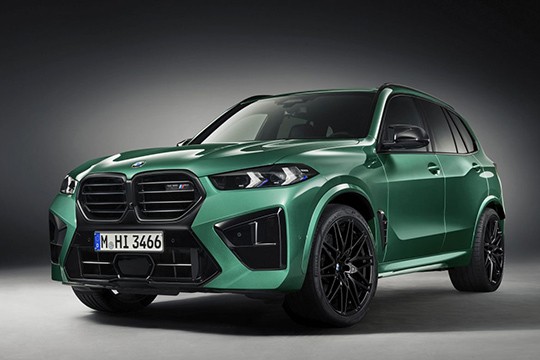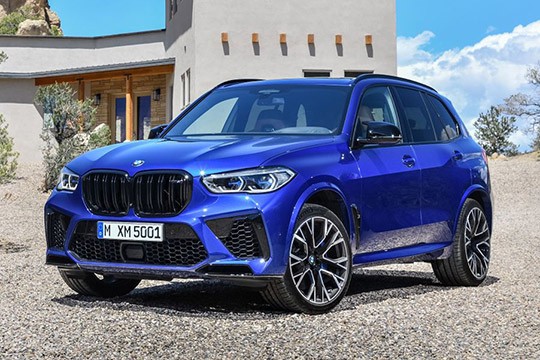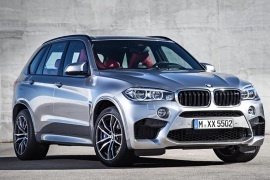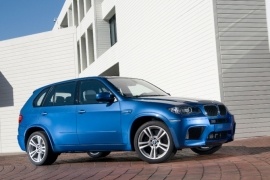BMW X5 M Models/Series Timeline, Specifications & Photos
First production year: 2009
Engines: Mild hybrid, Gasoline
Body style: SUV (Sports Utility Vehicle)
BMW refreshed the X5 lineup at the beginning of 2023, and along with the rest of the range, the M Competition version received a well-deserved update.
While customers started to ask for more performance-oriented SUVs that were good for families but also incredibly fast on regular roads, BMW stepped ahead. Starting with the second generation of the X5 it also introduced the M version. Fast forward to the fourth generation that was launched in 2019, and the M version was more powerful than ever, especially when fitted with the Competition package.
For the 2023 model year, the X5 M Competition received a new and improved front fascia fitted with slimmer headlights and a redesigned grille. This was broader and flanked by enlarged air intakes that cooled the massive front brakes. In addition, the lower bumper received a redesigned grille.
The X5 M Competition boasted a luxurious cabin with leather upholstery and a hexagonal pattern on the door cards. In addition, the automaker added carbon-fiber trims on the dashboard, center stack, and center console. BMW also installed a new dashboard fitted with a curved screen that hosted the instrument panel and the iDrive 8 infotainment system.
But the most significant changes were made under the car's skin. While the ICE powerplant remained the same, the automaker added a 48V mild-hybrid system that helped the
BMW X5 M Competition Competition 4.4L V8 xDrive 48V MHEV AWD 8AT (625 HP)
The X5 M was the top-performer of the X5 range and provided more power and torque than its predecessor, and, for those who thought that 600 hp are not enough, BMW offered an upgraded version.
When BMW introduced the first generation of the X5 in 1999, it became a sales-winner. It featured a unit-body construction, and that made it lighter than its main competitor, the Mercedes-Benz ML, which featured a body-on-frame architecture. Thus, BMW's first SUV became a tough competitor for all other premium carmakers. Fast forward two decades, and the X5 M came on the market with more power than three first-generation X5.
The 2019 X5 M featured a new front bumper than the rest of the X5 range. It sported a wider lower grille flanked by a pair of side-scoops and two more others on the car's apron. Its aggressive look was not only for show. All the scoops and air intakes were calculated by the company's engineers and were fully functional.
The leather-clad X5 interior featured a pair of high-bolstered seats at the front separated by a tall and wide center stack. Its sport bucket seats for the front passengers provided great side support for their occupants. In the back, there was the same flat bench with a 40/20/40 split system that increased the car's trunk from 650 liters to a maximum of 1,870 liters. The dashboard featured a pair of slim vents on the center stack, under the wide, 12.3" infotainment display. For the 2019 model, the X6 M sported a 12.3" digital instrument panel.
Under the hood, BMW M installed an evolved 4.4-liter twin-turbo engine. Unlike its predecessor, which offered 575 hp, the 2019 model provided 600 hp for the regular M and 625 for the Competition Package version.
The big SUV from BMW received an M-Technik implant in 2014. The Motorsport department developed the most powerful engine for an all-wheel-drive BMW ever and installed it in the X5. First, it took the 4.4-liter V8 gasoline engine and then plugged a pair of TwinScroll turbocharges, cross-bank exhaust manifolds, VALVETRONIC and High Precision Direct Gasoline Injection system. The result is a total output of 575 hp and 750 Nm (553 lb-ft) of torque. To send this energy to the wheels, M engineers installed a newly developed 8-speed Steptronic automatic gearbox.
From the outside, a new aerodynamic package was added. Large air intakes at the front end, side gills with a model badge and air breathers, signature M exterior mirrors in twin-stalk style, a typically M four-tailpipe exhaust system give it a standalone look M fans will immediately recognize. Setting the seal on this exclusive range of features are M-specific 20-inch light-alloy wheels with mixed tires or forged 21-inch M light-alloy wheels (optional).
The interior is fit for a high-performance vehicle, even if it is an SUV. As with all cars from the BMW brand, the design of the interior prioritizes intuitive usability. Also, M GmbH makes its own distinctive mark here. For example, the BMW X5 M come with a newly developed, ergonomically optimized M leather steering wheel with gearshift paddles, while the M gearshift lever has an equally distinctive design. The instrument cluster, M Drive menu in the information display, displays in the optional Head-Up Display and special multifunction switch with M Drive buttons on the steering wheel also fit the M template.
BMW introduced the most potent X5 to that date and added the notorious M badge on it, confirming that it can provide performance at any level for any ground clearance.
The X5 and X6 M were the first all-wheel-drive vehicles that ever sported the M-logo. Before that, the carmaker provided powerful versions ever since the first generation, with the 4.4-liter and the 4.6-liter engines, but those were not considered worthy enough to wear the magic light-blue, navy-blue, and red logo. That version came only on the second generation of the X5 in 2009.
Any M car had to tick more boxes than any other BMW, and the X5 followed the same procedure. BMW's motorsport department enhanced the car's look with new front bumpers with enlarged air dams. Two large and rectangular air scoops flanked the center lower grille. On its sides, the carmaker added M-specific badges on the front fenders. From its profile, the 20" light-alloy wheels with unique design emphasized the car's performance, while at the back, the four exhausts confirmed it.
Inside, the X5 featured a leather-clad interior with specific M-badges on the steering wheel, the gear selector, and inside the tachometer. Its power-adjustable sport bucket-seats promised good side support with their adjustable bolsters. Piano-black trims adorned the center console, the door cards, and the dashboard. Last but not least, a pair of aluminum paddle-shifters was mounted behind the steering wheel. For the rear passengers, BMW offered the same spacious split-folding bench.
BMW's motorsport department installed a twin-turbocharged 4.4-liter V-8 engine under the hood paired with a six-speed automatic transmission that sent the power in all corners. For stopping, the car featured four-pot calipers at the front and single-pot in the rear, while the all-wheel independent suspension was enhanced with adaptive dampers.



